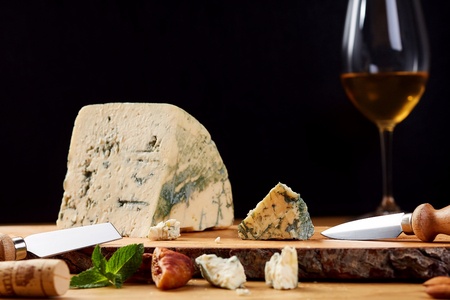
Roquefort cheese is to me one of the great monarchs of all cheeses, a real king. Greater than Cheddar or Wensleydale ? Actually, Wensleydale is an emperor but then it’s difficult to disagree with a cheese known as the ‘cheese of kings and popes’. Roquefort was said to be the choice of Emperor Charlemagne in the Holy Roman Empire. I imagine that isn’t often part of the essay answer when discussing the Merovingian dynasty and their success in Europe. It was certainly known about in Roman times as the great writer and historian Pliny describes this particular cheese. It has also been protected since 1411 in France which highlight how much its source of origin is so important.
The reason Roquefort earnt so much interest and respect in terms of texture and flavour is the presence of the sharp tasting blue veins produced by the mould Penicillium roquefortii which grows within them. The Chinese virtually banned it along with a few other cheeses because it was not a fungus they wished to recognise but that’s now been overturned.
Roquefort is only properly made in the little town of Roquefort-sur-Soulzon which I imagined is twinned with some lucky UK town somewhere. It has 600 people but is considerably swollen by all the tourists who want to visit the dank, chill caves where the cheese is made.
The story behind the blue veined wonder comes from the fable of a young shepherd eating cheese whilst guarding his flock. He spys a beautiful young maiden and immediately gives chase. Before he succumbs to lust, he hides his cheese with some rye bread in a cave, forgets where he put it and loses the girl all at the same time. He discovers it some months later because he is hungry and is searching for it. Its discovery is not what he expected. The cheese has gone mouldy with green and blue veins suffusing it but tastes it and voila it’s the beginning of a beautiful story for all of us.
In the original story, the cheese was prepared from a ewe’s milk curd and the cave harbours the eponymous mould which we now explain.
The critical feature is the fact that this cheese is prepared from a certain flock of sheep. These sheep are Lacaune which have been bred to produce their distinctive flavoured milk. The breed probably began in the mid-1800s when farmers mixed their flocks, cross-bred then with other regional sheep types and produced this unique race. The French Government of 1902 quite rightly defined the characteristics of the breed as a Kennel Club in the UK would a pedigree dog. The ewes are the critical sex here and their characteristic milk is perfumed, full of fat, can resist brutally harsh cold and hot temperature changes, has no horns, and weighs between 154 to 220 pounds. Each sheep yields 16 gallons of milk per season—some thirty times less than the average cow. This makes it a rare milk for a rare cheese, indeed but one that makes it so special.
All Roquefort is ‘grown’ in these damp, chilly caves near the town. Only seven businesses actually produce it. Each company guards its secret for production like a jealous lover. There are apparently 700 varieties of the mould Penicillium roqueforti and each one supposedly should create its own unique Roquefort cheese for consumption by pure aficionados who know how to use their nez to distinguish each one.
The cheese is made then from unpasteurised sheep’s milk where it is described as having a creamy but crumbly texture, be semi-soft, artisanal and blue-veined. The rind can be eaten and is salty, sharp with a tang. It is clearly not suitable for vegetarians who miss out on its wonderful flavour.
The critical feature too is the fact that this cheese is prepared from a certain flocks of sheep. the sheep are Lacaune which have been bred to produce their distinctive flavoured milk. The breed probably began in the mid 1800s when farmers mixed their flocks, cross-bred then with other regional sheep types and produced a unique race. The French Government of 1902 quite rightly defined the characteristics of the breed as a kennel Club in the UK would. the ewes are the critical sex here and their characteristics are they give perfumed full fat milk, resist brutal temperature changes, have no horns, and weigh between 154 to 220 pounds. Each sheep gives 16 gallons of milk per season—some thirty times less than the average cow—a rare milk for a rare cheese, indeed.
I use it in salads and dressings but frankly it graces an cheeseboard. Whilst it’s more expensive than other cheeses this one doesn’t cost an arm or a leg or any other appendage. It’s exceptional as a type of cheese for a Croque Monsieur, a sauce for beef steak and even to be eaten in a pear dessert.
Suppliers Of Roquefort Cheese
The key suppliers are the following:-
Roquefort Papillon, 8 bis ave de Lauras. website
Roquefort Société, 2 ave François Galtier, 05.65.58.58.58. website
Roquefort Gabriel, Coulet 3 ave de Lauras , 05.65.59.90.21. website
The other four producers show informative films or offer workshop visits:
Roquefort Carles, 6 ave de Lauras, 05.65.59.90.28. website
Yves Combes Roquefort Le Vieux Berger, Avenue du Combalou, 05.65.59.91.48.
Vernières Frères Quartier Saint Jean, 05.65.59.90.23. website
Les Fromageries Occitanes, Avenue de Lauras, 05.65.59.90.11. website
Please note this page contains links to our affiliate marketing partner. Please read our affiliate disclosure.
Leave a Reply